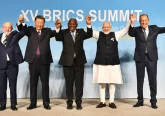That said, every time I hear someone sneer that the news of Pakistan or India’s imminent implosion has been grossly exaggerated, I am reminded of a lecture by Carl Sagan in the Forum of the Kennedy School of Government at Harvard, many years ago. I think he was talking about the danger of nuclear war, and the fact that the world had survived four decades of nuclear weapons without anyone using them, and said something to the effect that such an attitude was like if a man jumped off a hundred storey building, and while passing the thirty-eighth floor thought, “So far, so good.”
A more useful way to think about Pakistan’s prospects would be: what do the underlying trends suggest? And given the trends, what is the probability that Pakistan will still be with us ten, twenty or fifty years from now? The nation-states of Pakistan and India did not emerge out of some long-term organic evolution, but were carved out practically overnight by the departing British keen to jump with some ‘honour’ intact before being unceremoniously pushed. Far more powerful states have vanished from the map in recent times. The most obvious is the Soviet Union, which managed to con the world – and possibly itself – into thinking it was a “superpower”. It collapsed because it was built on an idea that did not work, after rotting from the inside over several decades. Another was Tito’s Yugoslavia, which lulled us into believing that ethnic nationalism had been successfully transcended by a larger, political identity.
This brings me to what I think is the biggest danger to Pakistan, more than war or poor governance, the usual suspects – which are conditions it shares with other countries including India. It is the idea, or rather the lack thereof, on which Pakistan rests. Asking whether Pakistan will exist in the future is actually a “trick” question: Pakistan already does not exist. That is, the country that emerged at the end of the British empire in India with the partition of 1947 – the “bloody creation” referred to by The Economist – ceased to exist in 1971. That country was meant to be a homeland for South Asia’s Muslims, some of whose leaders were apprehensive about becoming a minority in Hindu-majority India after the British departed. There is of course the argument that Jinnah, the founder of Pakistan, negotiating for “an equitable share of power at the all-India centre” for the subcontinent’s Muslims, had not intended to create the “moth-eaten” independent state he ended up with (see Ayesha Jalal, The Sole Spokesman, 1985, 1994; interestingly, something similar may have happened with Bangladesh, where Sheikh Mujib, negotiating to take power at the centre, ended up heading a separate state), but that is a different matter. The idea was a dubious one from the start – a large proportion of Muslims remained in ‘secular’ India, for instance. But after 1971, when more than half the population opted out on the basis of a different identity – that of being Bengali – the idea of Pakistan as a homeland for South Asia’s Muslims was well and truly bust.
The trouble is, what was left of Pakistan has not come up with an alternative identity. Recently Farzana Shaikh, author of Making Sense of Pakistan (2009), came to give a seminar at Oxford. The inescapable message of the ensuing discussion was that Pakistan remains unsure about why it exists. The tendency has been to cling on to the idea of Islam as a defining identity, in the face of sectarianism, strong regional identities, and pan-Islamic ideologies. A historical raison d’etre floated around the Indus – source of the current havoc – hasn’t exactly set anyone on fire, despite the enthusiasm of Aitzaz Ahsan (The Indus Saga, 1997), better known for his role in the lawyers’ movement against General Musharraf. In his recent book Bangladesh and Pakistan: Flirting with Failure in South Asia (2009) William Milam noted the somewhat different attempt by General Ziaur Rahman of Bangladesh to craft a territorial identity (which would include everyone within existing political boundaries), as opposed to an ethnic/linguistic “Bengali” idea of nationhood inevitably fraught with exclusion and conflict.
Here is where India holds a golden advantage. In contrast to its neighbour(s), India not only eschewed a ‘single-identity identity’, but it put diversity at the core of the ‘idea of India’. Hindu, Muslim, Sikh, Christian, Bengali, Punjabi, Italian… all can be Indian. India’s implosion, if and when it comes, would be due to poor execution, not any fundamental flaw in the concept. Having persisted with ‘Soviet-lite’ economic policies for four decades, India has been correcting the direction of its economy since 1991. The ensuing path of high growth has further improved its chances of holding together, giving its constituent parts more of a stake in the subcontinent-sized country. Where building nation-states is concerned, it would seem, money can buy you love.
But India’s political failures are also significant. ‘India’ as a political entity is likely still to exist in 2050, but probably with amended borders. It’s hard to see the Kashmir valley as part of that ‘India’ given the appalling record of India’s leadership in the former princely state of Jammu and Kashmir from the 1950s to the present day. Misgovernance mixed with weak historic and geographic connections plus a resurgent China puts the so-called ‘North East’ in doubt as well. There is some risk that immense inequalities and uneven regional development – left unchecked – might fracture what remains of ‘mainland India’ into multiple pieces. Prime Minister Manmohan Singh called the “Maoist” rebellion spreading across several states in the heart of India, the greatest security threat to India. But India in some form, more likely a single entity (minus Kashmir and the North East), will probably exist in 2050.
I’m afraid it is hard to visualize the same for Pakistan a few decades down the road. The problem of not knowing why it exists, combined with poor governance, multiple ambitious regional powers, and a multitude of other people’s wars, appears too lethal for this hapless country to overcome. And as we have seen elsewhere including its original incarnation, when the end comes, it tends to be all over fairly quickly.
Sarmila Bose is Senior Research Fellow in the Politics of South Asia, Department of Politics and International Relations, University of Oxford and the author of Dead Reckoning: Memories of the 1971 Bangladesh War, Hurst and Co. and Columbia University Press, 2010.
(* With great regret we have had to disable comments for this article. Many people have made good points both for and against the stable futures of Pakistan and India, but increasingly the comments have moved away from political analysis and towards what could be considered to be xenophobia, which is a form of debate that Politics In Spires cannot support. Thank you for your understanding.
– Editor. *)










6 Comments
Sarmila,
Very insightful. I wonder if you saw an article in a recent Economist, the thesis of which was that India is poised to
surpass China economically. I didn’t see it but wondered what was cited.
If Afghanistan and Iraq can exist, Pakistan with 300 nuclear weapons can exist without any doubt unless no one exists.
Well…. that’s the problem…the so called Pakistani nuclear weapons won’t hurt Pakistan…the Soviet Union had more nuclear weapons when it failed…Pakistan will collapse because of no governance.. struggle of power between army, ISI, so called government, jihadis etc…I still can’t imagine how many centres of Power are there in Pakistan… the country gets on average 50 suicide attacks per month by home grown jihadis…they still boast of their existence in 2050…Well…I would say…Not even in my wildest dreams…
Well….what to say over Pakistan, poverty, terrorism, corruption, Jihadis, are four pillar of Pakistan state, moreover a recent attack over their navy base by their own Jihadis, those who destroy of their two air crafts of its own country……Now after this incident who can say that Pakistani nuclear weapons are safe.
oops…… I forgot to mentioned about their father of nation Osama residence in pakistan. I know no more words are required to explain the current scenario..forget about 2050,…it is really hard to pakistan to cross 2025.
I feel that pak was never was a viable nation idea. Nation created on religious identities and anti- indianness itself was denial to one’s own identity. we all know India and Pak were basically same in blood and culture. If every one in pak and India could trace the family 15 generation above, every one will be Indian and hindus at both countries and brothers and sisters. Muslims invaded only after Babur in only 1000 years ago. what Pak leaders did after separation was to remove the common history of the region to the kids and if at all told only limited distorted lessons suiting to their leadership and politics. Anti-indianism resulted in loosing the identity that they had. Now they are asking who we are? In my view 2 Nation theory itself was having defects. In fact it was only one nation culturally, ethnically, linguistically, historically and socially, politically. In any case, time will only tell that how long Pak leaders and Army can fool the civil society of itself that India is threat to them and india is different than pak. sooner or later every one will realize that basically it is all same every where.
With great regret we have had to disable comments for this article. Many people have made good points both for and against the stable futures of Pakistan and India, but increasingly the comments have moved away from political analysis and towards what could be considered to be xenophobia, which is a form of debate that Politics In Spires cannot support. Thank you for your understanding.